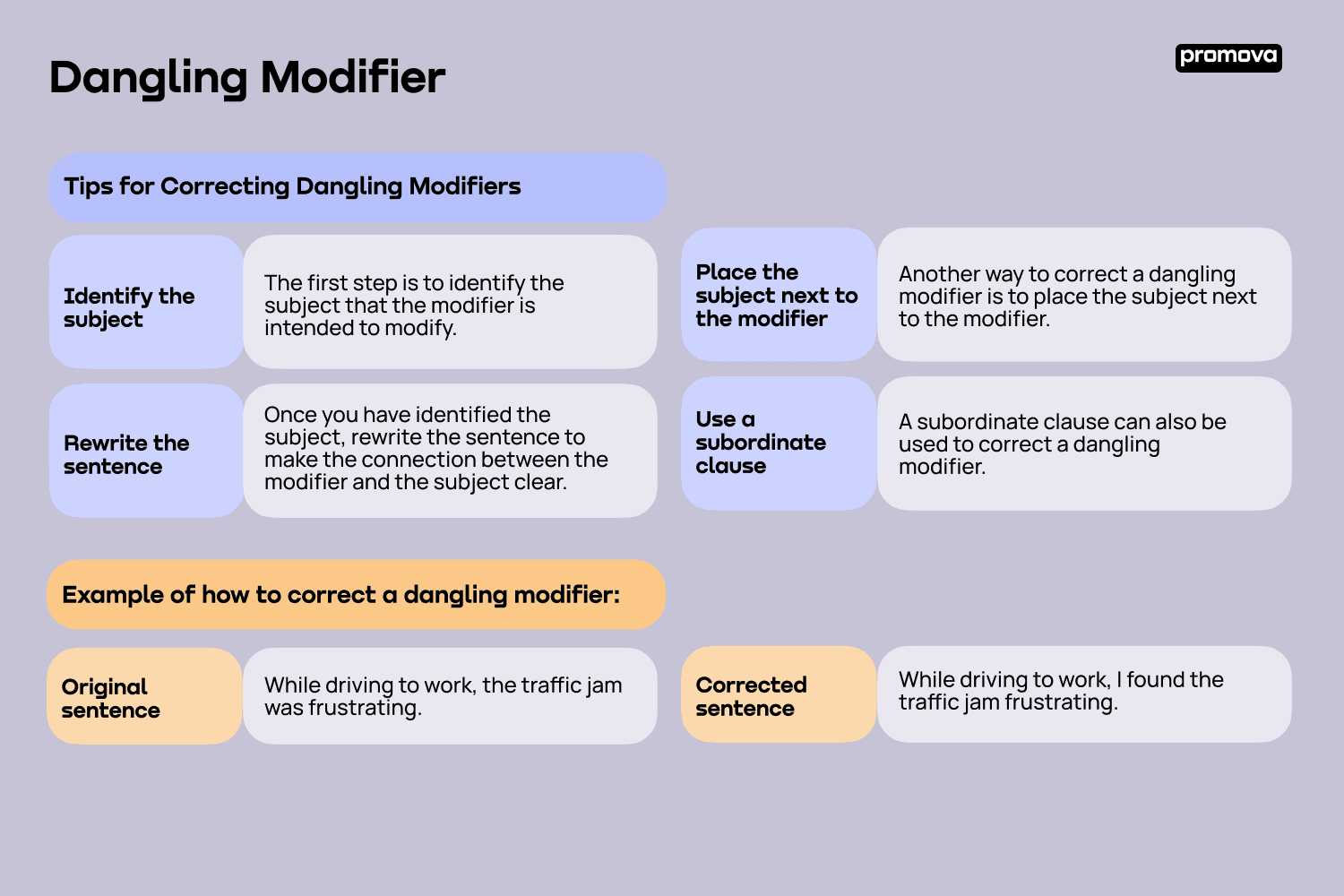Dangling Modifier
Contents
If you are currently learning English, you may have heard about dangling modifiers. Dangling modifiers are common grammatical errors that can make your writing or speech confusing or even misleading. In this reference, we will discuss what a dangling modifier is, how to identify it, and why avoiding it is important. We will also provide examples of dangling modifiers and tips on how to correct them.
What is a Dangling Modifier?
A dangling modifier is a type of misplaced modifier that does not have a clear or logical connection to the subject it is modifying. In other words, a dangling modifier is a phrase or clause that is intended to modify a word or phrase in a sentence but is placed in the wrong position, making the sentence unclear or semantically incorrect.
For example, "Walking to the park, the trees looked beautiful." In this sentence, the phrase "Walking to the park" is the dangling modifier because it does not modify any specific noun or pronoun. The sentence implies that the trees were walking to the park, which is incorrect.
How to Identify a Dangling Modifier?
Identifying a dangling modifier can be challenging, especially for non-native speakers. However, there are some clues that can help you spot a dangling modifier.
- Look for introductory phrases that describe an action without identifying the actor. For instance, "Having finished his homework, the TV was turned on." In this sentence, the introductory phrase "Having finished his homework" is the dangling modifier because it does not have any connection to the subject "the TV."
- Look for phrases that use "-ing" or "-ed" verbs that do not clearly identify the subject. For example, "Running down the street, the car hit the curb." In this sentence, the phrase "Running down the street" is the dangling modifier because it does not have any clear connection to the subject "the car."
Examples of Dangling Modifiers
Here is how this can look like in sentences:
- "After reading the book, the movie was watched." (The movie did not read the book)
- "Hiking in the mountains, the air was fresh." (The air was not hiking)
- "To find the answer, the question needs to be asked." (The question cannot find the answer)
As you can see, dangling modifiers can create confusion and ambiguity in a sentence.
Why we avoid dangling modifiers
Dangling modifiers can make your writing or speech unclear, confusing, or even misleading. It can also make you appear unprofessional or careless.
Imagine you are writing a report for your boss, and you use a dangling modifier that misleads the reader. Your boss may lose trust in your ability to communicate effectively, or worse, it may affect the company's reputation. Therefore, avoiding dangling modifiers is crucial for clear and accurate communication.
4
Tips for Correcting Dangling Modifiers

Now that you understand the dangling modifier and why it is important to avoid it, let's explore some ways to correct it.
- Identify the subject: The first step is to identify the subject that the modifier is intended to modify.
- Rewrite the sentence: Once you have identified the subject, rewrite the sentence to make the connection between the modifier and the subject clear.
- Place the subject next to the modifier: Another way to correct a dangling modifier is to place the subject next to the modifier.
- Use a subordinate clause: A subordinate clause can also be used to correct a dangling modifier.
Here is an example of how to correct a dangling modifier:
Original sentence: "While driving to work, the traffic jam was frustrating."
Corrected sentence: "While driving to work, I found the traffic jam frustrating."
As you can see, by identifying the subject (I) and placing it next to the modifier (while driving to work), we have corrected the dangling modifier.
Other Mistakes Similar to Dangling Modifiers
There are some other grammatical mistakes that are similar to dangling modifiers, such as misplaced modifiers, ambiguous pronoun references, and passive voice.
- Misplaced modifiers are placed too far away from the word or phrase they are modifying.
- Ambiguous pronoun references occur when the pronoun in a sentence can refer to more than one noun.
- Passive voice is a type of sentence where the subject receives the action instead of performing it. It's not a grammar mistake, but can often be confusing for learners.
Summary
Dangling modifiers are common grammatical errors that can make your writing or speech unclear or misleading. They occur when a phrase or clause modifies the wrong word or phrase in a sentence. To avoid dangling modifiers, you should identify the subject, rewrite the sentence, place the subject next to the modifier, or use a subordinate clause.
By correcting dangling modifiers, you can make your writing or speech clear and accurate, which can help you convey your message more effectively. Good luck on your language learning journey!



Comments